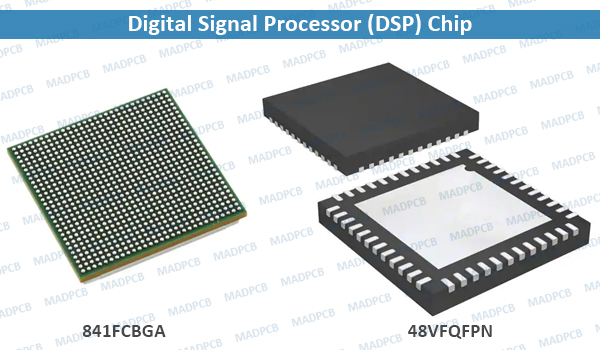What’s DSP Chip?
A Digital Signal Processor (DSP) is a specialized microprocessor chip, with its architecture optimized for the operational needs of digital signal processing, usually in real-time. DSPs can also be used to perform general-purpose computations; however, they are not optimized for this function. Instead, DSPs use an instruction set architecture (ISA) that is optimized for rapid signal processing.
Important ISA features include deep pipelining to enhance microprocessor performance and the ability to act as a direct memory access device (DMA) for the host environment. Digital signal processors also use Harvard architecture with separate program and data memory. In addition, DSPs use saturation arithmetic so that overflow operations accumulate at the maximum or minimum values that the register can hold instead of wrapping around.
With DSPs, the maximum remains the maximum. By contrast, with many general-purpose CPUs, the sum of the maximum plus one equals the minimum. Most digital signal processors are fixed-point devices because in real-world signal processing, extra precision is not required and there is a large speed benefit. Floating-point DSPs are common in scientific and other applications that require precision. Digital signal processors feature specialized instructions, modulo-addressing in ring buffers, and bit-reversed addressing mode for Fortran function tree (FFT) cross-referencing.
Generally, DSPs are dedicated integrated circuits (ICs); however, DSP functionality can also be realized using field programmable gate array (FPGA) chips. DSPs are used in several classes of computer hardware, including sound cards, modems, telephony boards that handle sound and modem functions, and hardware that handles audio and video compression in real time.
How Is Digital Signal Processing?
Imagine you’re asking something from a smart speaker, such as a search of the nearest sushi restaurants. Analog-to-digital converters take your speech input and turn it into zeros and ones. These values are then transferred to a digital signal processor as an input, and the processor then analyzes these signals to turn them into words that can be processed. After processing, it will return a digital representation of its response to a waiting digital-to-analog converter that will output the information back to the user over a speaker.
Hypothetically, this same sequence of events could be done with analog signal processing, but it would be significantly more complex, and changes to the algorithm would require a lot of tweaking. Additionally, changes to the processing algorithm would require physical components to be optimized. By comparison, DSP code can be changed instantly without the large component upkeep. To add to its benefits, since DSP inputs are digital, they will give the same output for any given input every time. Physical analog components have anomalies that can change with varying operating conditions.
Where Is DSP Used?
They are widely used in audio signal processing, telecommunications, digital image processing, radar, sonar and speech recognition systems, and in common consumer electronic devices as mobile phones, disk drives and high-definition television (HDTV) products.
DSP technology is often a key component of artificial intelligence (AI) applications, including natural language processing (NLP). NLP is used so that computers and devices can understand and analyze human language and behaviors by converting it into the “natural language”.
DSP technology is used across a variety of devices because the encoding and decoding techniques are standard. Unlike analog signals, which are prone to distortion, interference and even security breaches, DSP is a good option for high-speed applications requiring encryption, compression and rapid transmission.
Specifications
Selecting digital signal processors requires an analysis of performance specifications. DSPs operate with variety of supply voltages and include data buses that range from 8-bit to 256-bit devices. DSPs also vary in terms of clock speed, which is typically expressed in megahertz (MHz) and gigahertz (GHz). Often, integrated on-chip phase-locked loops (PLLs) with clock frequency synthesis capabilities are used to design high-speed internal clocks for data sampling in DSP applications.
Measurements of DSP processing power include million instructions per second (MIPS) and million multiply / accumulates per second (MMACS). For floating-point devices, an additional measurement is million floating-point operations per second (MFLOPS). For all DSPs, the operating current, operating temperature, and power dissipation are also important specifications.
Features and Options
Digital signal processors are available with multiple DMA channels and a variety of I/O ports and interfaces. Some devices also feature an external memory interface that determines the amount of memory a chip can handle. Parallel interfaces include:
- Universal asynchronous receiver transmitter (UART)
- Universal synchronous asynchronous receiver transmitter (UART) technology
Serial interfaces include:
- Peripheral component interconnect (PCI)
- Universal serial bus (USB)
- Enhanced synchronous serial interface (ESSI)
- Serial communications interface (SCI)
C6000 DSP+ARM Processor 256-BGAThe Joint Test Actions Group (JTAG), a standards organization, has developed a test access port (TAP) that allows access to the inner workings of ICs. Inter-IC (I²C) is used to control and monitor applications in communications, computer, and industrial settings.
DSP Packaging Types
Common package types for digital signal processors (DSPs) include:
- Ball grid array (BGA)
- Quad flat package (QFP)
- Single in-line package (SIP)
- Dual in-line package (DIP)
Many packaging variants are available. In terms of additional features, some DSPs include an internal memory interface, embedded timers, or Flash memory. Other devices include on-chip A/D converters that convert analog inputs into digital signal.

